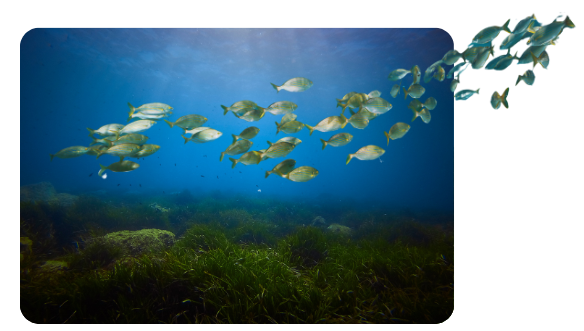Story
How do we address the complex issue of microplastic pollution?
10 April 2024
International experts gather for panel discussions during UN Ocean Decade event in Barcelona.

The impacts of microplastics on the marine environment and the complexity of the science and monitoring required to better understand the issue and support improved regulation was in focus at the “Global Awareness, Research Activities, and Network to address Ocean Microplastic Pollution’ satellite event today (April 9th) as part of the UN Ocean Decade Conference and Ocean Week in Barcelona, organised by NORCE and the International Atomic Energy Agency (IAEA) with partner organisations.
Microplastic pollution, which stems from the degradation of larger plastic items or the direct release of tiny plastic particles, is known to affect ecosystems worldwide, from the depths of the ocean to remote mountaintops. Often containing harmful chemicals, microplastics contaminate water bodies, soil, and air, posing severe threats to marine life, wildlife, and human health. Ingested by marine organisms, they disrupt digestive systems and bioaccumulate through the food chain, potentially through to human consumption.
During the “Addressing Marine Microplastic Pollution’ session of the event, Plymouth Marine Laboratory (PML) Marine Ecosystem Modeller Dr James Clark joined Andy Booth from SINTEF Ocean, Norway, and Alessio Gomiero from the Norwegian Research Centre and the North Atlantic Microplastic Centre for the first of two panel discussions.

The panellists highlighted that improved international collaboration, joined-up regulation and an acceleration of the science required to understand the impact of chemicals associated with plastic pollution are among the actions urgently required to help tackle the issue. Furthermore, they highlighted that increased capacity for monitoring at localized and global level is critically needed.
“Microplastics are an incredible complex and challenging area of research”, said Dr Clark, who has been involved in microplastics research since 2014. “They can be hard to detect and it is often difficult to stop them entering the environment. Technology and innovation have a key role to play as we look for better mechanisms to stem the issue.”
Referencing the proposed Global Plastics Treaty (GPT), for which 75 UN Member States expressed support in 2022, he added:
“Due to the ways in which both larger plastics and microplastics travel through the environment, associated damages will be felt by countries other than those responsible for the emissions. To maximise the effectiveness of any future global agreement, it is important that countries cooperate on funding and implementing plans to reduce their emissions.”
Alessio Gomiero from the Norwegian Research Centre of the North Atlantic Microplastic Centre Norway said:
“In terms of rules and regulation we need to stay open to the changing science on microplastic toxicity and its transportation dynamics. From the impact of degraded plastics to car tyre particles, paint particles and their associated additives there are novel areas of research emerging which demand to be addressed. It’s vital that further research is carried out on the behaviour of microplastics in the environment to provide new insights to regulators.”
Andy Booth from SINTEF Ocean, Norway said:
“The chemicals associated with microplastics present an evolving challenge as science tries to keep up with the changes taking place within industry. There are around 16,000 chemicals found within microplastics, with some already known to be toxic, but a lack of toxicity data for the majority of chemicals. Marine organisms and ecosystems are not necessarily able to handle these chemicals, especially as complex mixtures, so this is a major issue. Much better understanding is needed.”
During the second panel session a number of success stories of marine plastic monitoring networks at international level were showcased by a number of distinguished panellists, including: Florence Descroix-Comanducci – Director IAEA Marine Environment Laboratories, Keshnee Pillay – Department of Forestry, Fisheries &the Environment South Africa, Noriko Tamiya-Hase – Ministry of Environment Japan, Captain Arias-Isaza – Director General INVEMAR Colombia.
In addition to exploring future directions on research, risk assessment and the importance of partnerships, the discussions also reflected on the significant efforts and resources required to establish a monitoring baseline for marine plastic pollution.
Vanessa Hatje, IAEA scientist and co-chair of Working Group 1 to Challenge 1 of the UN Ocean Decade: To understand and beat marine pollution’ said:
“These knowledge gaps put us in a complicated position, especially in terms of creating and implementing policies protecting marine environments and organisms. The creation and dissemination of harmonized data and development of harmonized methodologies are crucial to filling these knowledge gaps.”
Ms. Florence Descroix- Comanducci, Director of IAEA Marine Environment Laboratories said:
“We are committed to supporting our member states in surveying these emerging pollutants and building their ability to compare their data gathered using harmonized methodologies and protocols for science informed policy.”
During the session a number of key announcements were made:
- IAEA NUTEC marine plastics – its network, capacity-building efforts and the research and development work held in IAEA Marine Environment laboratories in Monaco will be included as an UN Ocean Decade action
- South Africa proposed a UN Ocean Decade project on inter-regional ocean microplastic monitoring within Africa
- Japan’s Ministry of Environment – will launch (in May 2024) new initiatives for harmonized methodology for monitoring microplastics and a data portal in collaboration with international partners.
- The North Atlantic Microplastics Centre – NAMC will continue contributing to the UN Ocean Decade actions and cooperate with IAEA NUTEC to both establishing a plastic research infrastructure network and promoting focused and innovative research.
